🍐 The History of Pear-Flavored Candy 🍐
Craving something sweet? Jump to my top 5 favorite pear candies!
Candy, with its vast array of flavors and textures, has the unique ability to transport us to different moments in time and evoke memories of childhood and simpler days. Among the diverse spectrum of candy flavors, the subtle and sweet taste of pear holds a special place. The history of pear-flavored candy is a captivating journey through the annals of culinary innovation, cultural influences, and the timeless allure of this delightful fruit. Let's embark on a 1000-year odyssey to explore the fascinating history of pear-flavored candy, from its ancient origins to its contemporary popularity. Here we go!
🍐 Ancient Pear Delights 🍐
The story of pear-flavored candy traces its roots to ancient civilizations where candied fruits were treasured as rare and precious treats. Pears, with their juicy sweetness and fragrant aroma, were one of the fruits often preserved in honey or sugar syrup in ancient Persia, Egypt, and China. These early versions of candied pears were a testament to the appreciation of this delectable fruit.
In medieval Europe, the art of candying fruits, including pears, became more refined. Sugar, a luxury imported from Asia and the Middle East, was used to create confections for the nobility and clergy. Candied pears, often coated in sugar and sometimes flavored with spices or floral essences, became highly sought-after delicacies during feasts and celebrations.
🍐 The Renaissance and the Golden Age of Confectionery 🍐
The Renaissance period marked a significant turning point in the history of pear-flavored candy as it saw the proliferation of sugary confections and the refinement of candy-making techniques. Italian confectioners, known as "confettieri," played a central role in shaping the art of confectionery during this era. They specialized in creating ornate sugar sculptures, including fruits and flowers, some of which were flavored with pear essence.
The Renaissance also witnessed the publication of the first European cookbooks, some of which contained recipes for making pear preserves and candies. These recipes often called for cooking pears with sugar and spices until they became soft and infused with a delicate sweetness. Pear-flavored candies, known as "comfits" or "sugar plums," were offered as after-dinner treats and were also used as medicinal remedies for ailments.
🍐 The 18th Century: Pear Drops and Innovations 🍐
The 18th century brought further innovations in confectionery, leading to the creation of pear-flavored hard candies known as "pear drops." These candies were made by boiling sugar and pear flavoring to create a firm, translucent candy with a pronounced pear taste. Pear drops quickly gained popularity in England and became a beloved classic.
One notable development during this period was the refinement of fruit essences and extracts. Advances in distillation techniques allowed candy makers to capture the true essence of pear, resulting in a more authentic and intense flavor. The availability of pear essence revolutionized the production of pear-flavored candy, making it more accessible and consistent in quality.
🍐 The 19th Century and the Spread of Pear Candy 🍐
The 19th century witnessed the global spread of pear-flavored candy as trade networks expanded and exotic flavors became more accessible. Pear-flavored hard candies, taffies, and chewable lozenges were produced in Europe and the United States, offering consumers a variety of pear-flavored options.
One iconic pear-flavored candy that emerged during this time was the Pear Drop, known for its vibrant yellow color and pear-shaped appearance. These hard candies, often found in charming tin containers, became a symbol of sweet nostalgia. Pear Drops were enjoyed by people of all ages and were often associated with cherished childhood memories.
🍐 The Mid-20th Century Boom 🍐
The mid-20th century witnessed a surge in the production and consumption of pear-flavored candy, fueled by post-World War II economic prosperity and a growing interest in unique and exotic flavors. Pear-flavored taffies, gummy candies, and jellies became readily available in candy shops and supermarkets.
One iconic pear-flavored candy that gained immense popularity during this period was the Pear Jelly Belly. Jelly Belly, known for its wide range of gourmet jellybean flavors, introduced the pear flavor, capturing the authentic taste of ripe pears. The introduction of the Pear Jelly Belly expanded the horizons of candy flavors, offering consumers a delightful taste of this beloved fruit.
🍐 Modern-Day Pear Candy 🍐
n the contemporary candy landscape, pear-flavored candy continues to be a cherished favorite. Its versatility is evident in the wide range of pear-flavored confections available today, from pear-flavored lollipops to pear-infused chocolate bars. Candy makers have embraced pear as a flavor that pairs well with other fruits, such as pear-apple or pear-peach combinations, offering a unique and refreshing taste experience.
One notable trend in modern pear-flavored candy is the use of natural ingredients and flavor authenticity. With the growing demand for natural and organic products, candy manufacturers are increasingly using real pear puree or juice to enhance the flavor of their candies. This commitment to authenticity ensures that the taste of pear in candy remains true to the fruit's essence.
🍐 The Role of Pear Candy in Popular Culture 🍐
Pear-flavored candy, with its sweet and delicate taste, has made its mark on popular culture. Its gentle flavor and appealing color make it a symbol of simplicity and charm. Pear candies often appear in literature, film, and television as representations of innocence and sweetness.
One notable example is the classic children's book "The Very Hungry Caterpillar" by Eric Carle, where the protagonist, a hungry caterpillar, munches through a variety of fruits, including a pear. The image of the caterpillar enjoying a juicy pear has become an iconic symbol of wholesome and delightful nourishment.
Pear-flavored candies also play a role in celebrations and traditions. In some cultures, pears are considered a symbol of prosperity and good luck, and pear candies are often exchanged during holidays and special occasions. This practice reinforces the idea that pear-flavored candy is not just a sweet treat but also a symbol of good fortune and abundance.
The history of pear-flavored candy is a delightful journey that reflects the evolution of taste preferences, culinary exploration, and the enduring appeal of this beloved fruit. From its ancient origins in honeyed delicacies to its modern-day presence in a wide array of confections, pear-flavored candy has captured the hearts and taste buds of generations. Its subtlety, sweetness, and versatility make it a cherished choice in the world of candy. As we savor a piece of pear-flavored candy, we can appreciate the rich history and cultural significance that have made this gentle and delectable flavor a timeless favorite—a symbol of simplicity and sweet delight.
🍐 Pear Candy Recommendations 🍐
Here are some links to my favorite candies!
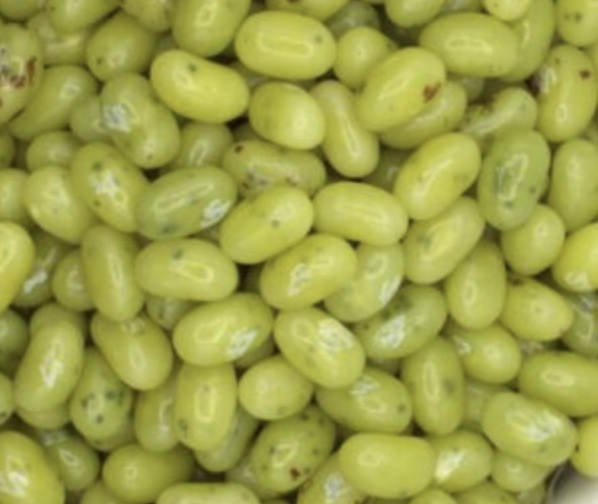
• Juicy Pear Jelly Belly Jelly Beans (Amazon): thse Jelly Belly jelly beans boast the juciest natural pear flavor of all the pear-flavored candies I've tried.
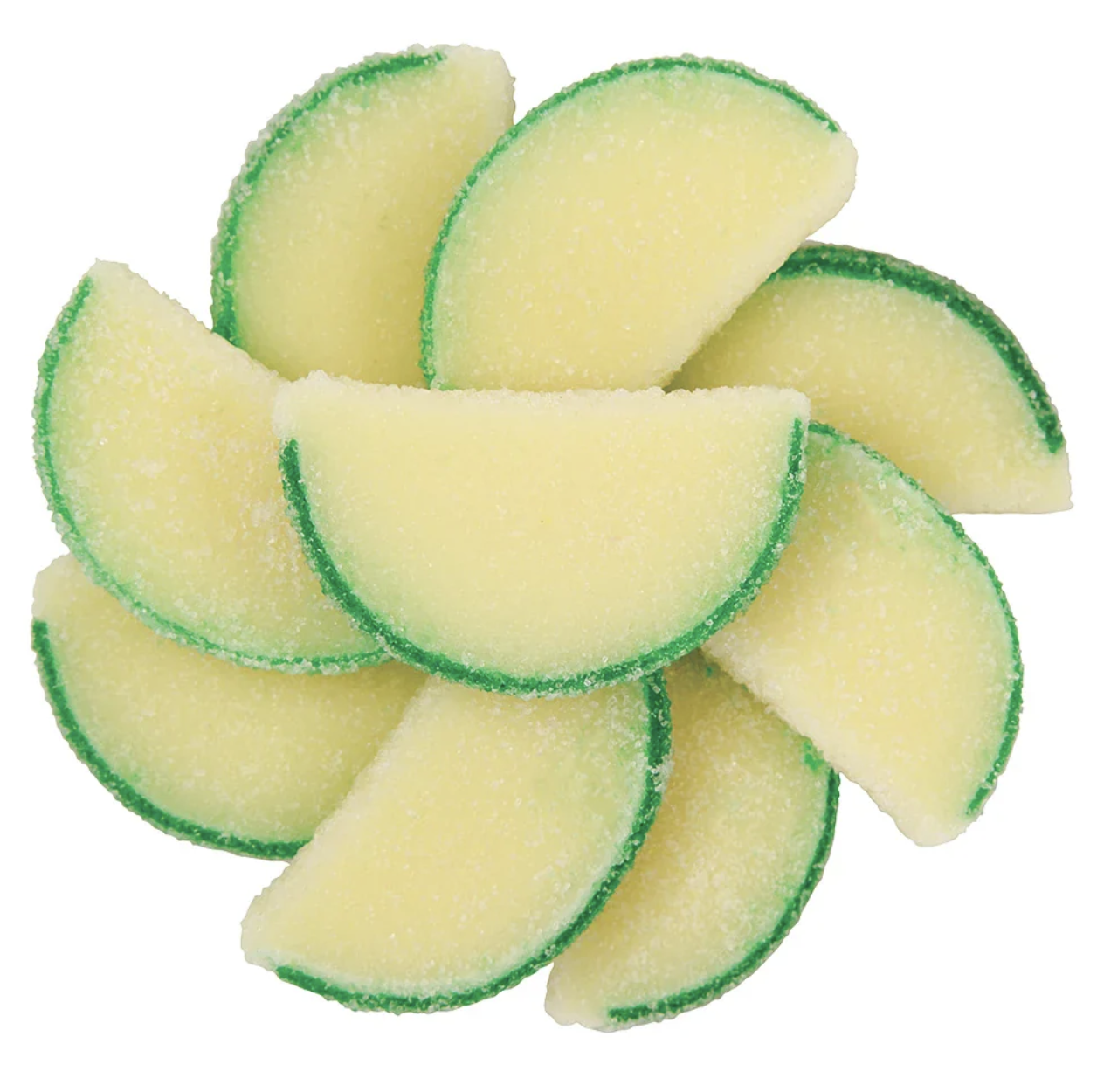
• Pear Jelly Fruit Slices (Amazon): ok, these definitely don't have a "gourmet" (realistic) pear flavor, but I am a sucker for the crunchy-chewy rind on jelly slices!
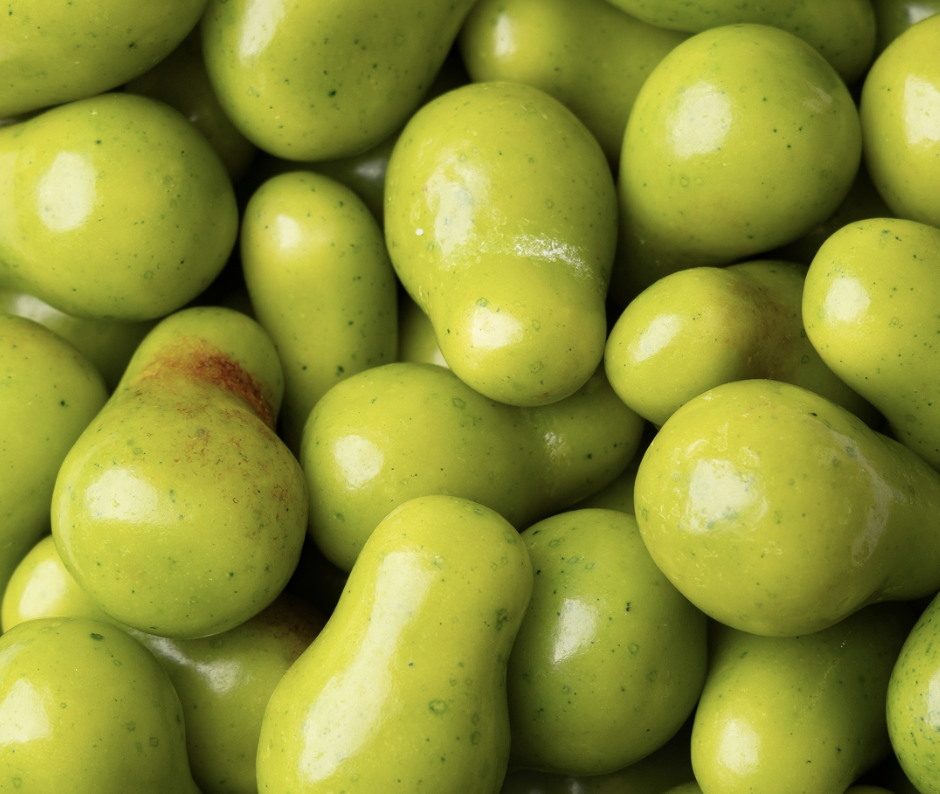
• : Swiss Pear Candy (Amazon): these pear candies give Jelly Bellies a run for their money — they're basically supersized versions of pear-flavored Jelly Bellies.
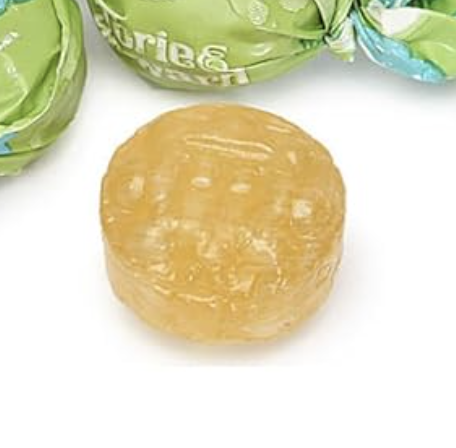
• Pear & Cinnamon Hard Candy (Amazon): a well-balanced combination of cinnamon and pear, like baked pear crisp in hard candy form. Delightful!
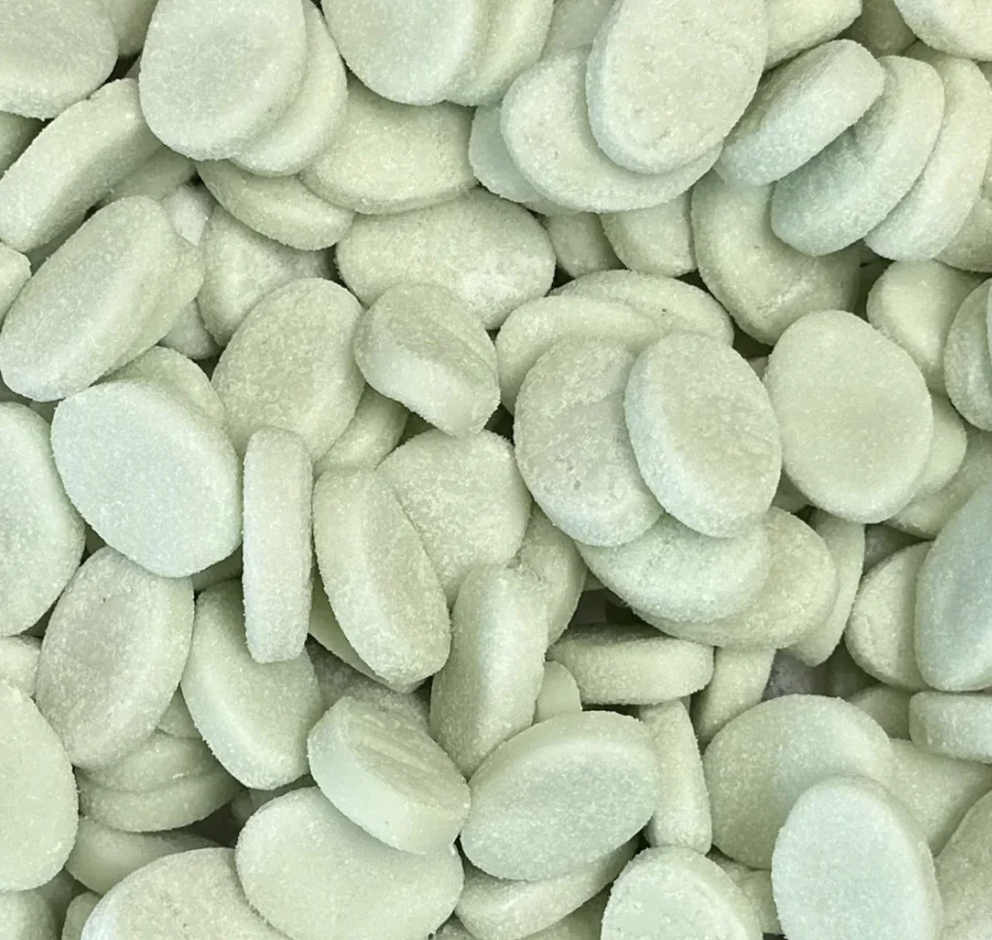
• Sour Pear Soft Gummies by Bubs (Amazon): very unusual compared to the clear and bouncy gummies typically found in US marketplaces. These Swedish soft gummies might not be to everyone's taste, but they're definitely worth a try!
🚨 BONUS ARTICLE! 🚨
🌵 The History of Prickly Pear Cactus-Flavored Candy 🌵
Craving something sweet? Jump to my favorite prickly pear candies!
Candy has an extraordinary capacity to transport us to different times and places through its wide array of flavors and textures. Among these diverse candy flavors, the exotic and intriguing taste of prickly pear holds a unique allure. The history of prickly pear flavored candy is a captivating tale of cultural influences, culinary innovation, and the quest for unique taste experiences. In this essay, we will embark on a 1000-year journey through time to explore the fascinating history of prickly pear flavored candy, from its ancient origins to its contemporary popularity.
🌵 Ancient Roots of Prickly Pear 🌵
The story of prickly pear flavored candy begins in ancient civilizations where the fruit of the prickly pear cactus, also known as "nopales" or "tuna," was revered for both its culinary and medicinal properties. Native to the Americas, prickly pear has a long history of use by indigenous peoples who cultivated and consumed it for thousands of years.
In ancient Mexico, for instance, the Aztecs and the Maya revered the prickly pear cactus as a symbol of life and fertility. The fruit, known as "tuna" in their languages, was used to make beverages, jams, and sweets. These early forms of prickly pear candies were created by boiling the fruit pulp with honey or agave syrup, resulting in a sweet and tangy treat.
🌵 Prickly Pear Candy in the Middle East and Mediterranean 🌵
The influence of prickly pear candies spread beyond the Americas, reaching the Middle East and the Mediterranean through trade and exploration. During the medieval period, when trade routes connected the Old World to the New World, exotic fruits like prickly pear made their way into European culinary traditions.
In the Middle East and North Africa, prickly pear fruit candies were known as "sabra," a term used to refer to both the fruit and the candies made from it. Sabra candies were often flavored with regional ingredients such as rosewater or orange blossom water, adding a delightful floral dimension to the natural sweetness of the prickly pear.
🌵 The Renaissance and the Age of Exploration 🌵
The Renaissance period marked a significant turning point in the history of prickly pear flavored candy. European explorers and colonists brought back exotic flavors and ingredients from their journeys to the Americas. Prickly pear fruit, with its vibrant colors and distinctive taste, was among the novel ingredients introduced to Europe during this era.
The fruit of the prickly pear cactus was initially cultivated in the Mediterranean region, particularly in Spain and Italy. As a result, prickly pear candies became part of the confectionery landscape in these countries. Prickly pear jelly, flavored with spices like cinnamon and clove, was a common treat during feasts and celebrations.
🌵 The 18th and 19th Centuries: Candy Innovations 🌵
The 18th and 19th centuries marked a period of significant innovation in confectionery. Advances in sugar refining and candy-making techniques paved the way for a wider variety of candies, including those with prickly pear flavor.
One notable development was the creation of prickly pear-flavored hard candies. These candies were made by boiling sugar, prickly pear juice, and sometimes citrus zest to create a flavorful syrup, which was then shaped into hard candies. The unique combination of sweetness and tartness made prickly pear hard candies a popular choice among consumers.
Prickly pear taffy also emerged during this time. Taffy, a chewy and stretchy candy, allowed confectioners to capture the essence of prickly pear while delivering a delightful texture. Prickly pear taffy quickly gained popularity, especially in regions where the fruit was abundant.
🌵 The Mid-20th Century: Prickly Pear in the United States 🌵
The mid-20th century witnessed the introduction of prickly pear-flavored candy to a broader audience in the United States. As interest in international flavors and exotic fruits grew, American candy makers began to experiment with prickly pear flavor.
One iconic prickly pear-flavored candy that gained popularity during this time was the Prickly Pear Cactus Candy. These candies, often made in the shape of cacti or colorful rounds, offered a unique taste experience. Prickly Pear Cactus Candy was appreciated not only for its flavor but also for its association with the American Southwest, where the prickly pear cactus is a symbol of resilience and endurance.
🌵 Modern-Day Prickly Pear Candy 🌵
In the contemporary candy landscape, prickly pear-flavored candy continues to thrive, combining tradition with innovation. Prickly pear flavor can be found in a variety of candy forms, from gummy candies and lollipops to prickly pear-flavored ice cream and chocolates.
One notable development in recent years is the fusion of prickly pear with other flavors to create unique and exotic candy experiences. For example, prickly pear and lime-infused candies offer a delightful blend of sweet and tart, reminiscent of the refreshing fruit drinks enjoyed in the desert regions of the Americas.
🌵 The Role of Prickly Pear Candy in Popular Culture 🌵
Prickly pear-flavored candy, with its exotic and intriguing taste, has made its mark on popular culture. Its vibrant color and unique flavor make it a symbol of adventure and discovery. Prickly pear candies often appear in literature, film, and television as representations of exploration and the allure of the unknown.
One notable example is the use of prickly pear candy in literature set in the American Southwest. Authors often describe the taste of prickly pear candy as a delightful surprise, capturing the essence of the region's natural beauty and flavors.
Prickly pear-flavored candies are also featured in cultural celebrations and traditions. In the southwestern United States and Mexico, prickly pear candies are enjoyed during festivals and holidays, adding a touch of local flavor to the festivities.
The history of prickly pear-flavored candy is a fascinating journey that reflects the evolution of taste preferences, culinary exploration, and cultural influences. From its ancient origins in the Americas to its global popularity today, prickly pear-flavored candy has captured the imagination and palates of generations. Its exotic and intriguing flavor, coupled with its vibrant history, make it a beloved choice in the world of candy. As we savor a piece of prickly pear-flavored candy, we can appreciate the rich history and cultural significance that have made this unique and delightful flavor a timeless favorite—a symbol of adventure and the sweet taste of discovery.
🌵 Prickly Pear Candy Recommendations 🌵
Prickly pear confections are growing in popularity as opuntia (prickly pear) plants naturally thrive in the desert climate of the southwestern United States, often burgeoning with fruit in public parks and residents' own backyards. Here are some classic prickly pear candies!
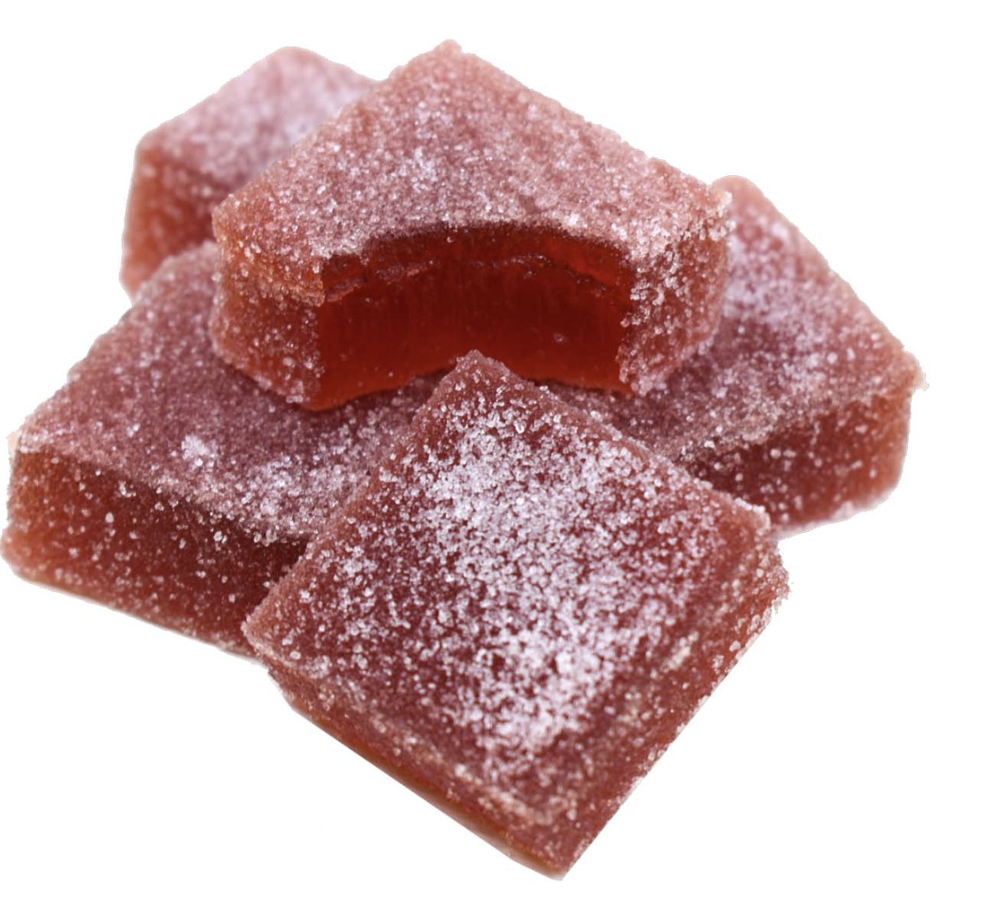
• Cactus Candy: Prickly Pear Jellies (Amazon): the classic cactus jelly candy! This jelly candy captures the unique flavor of the prickly pear quite well.
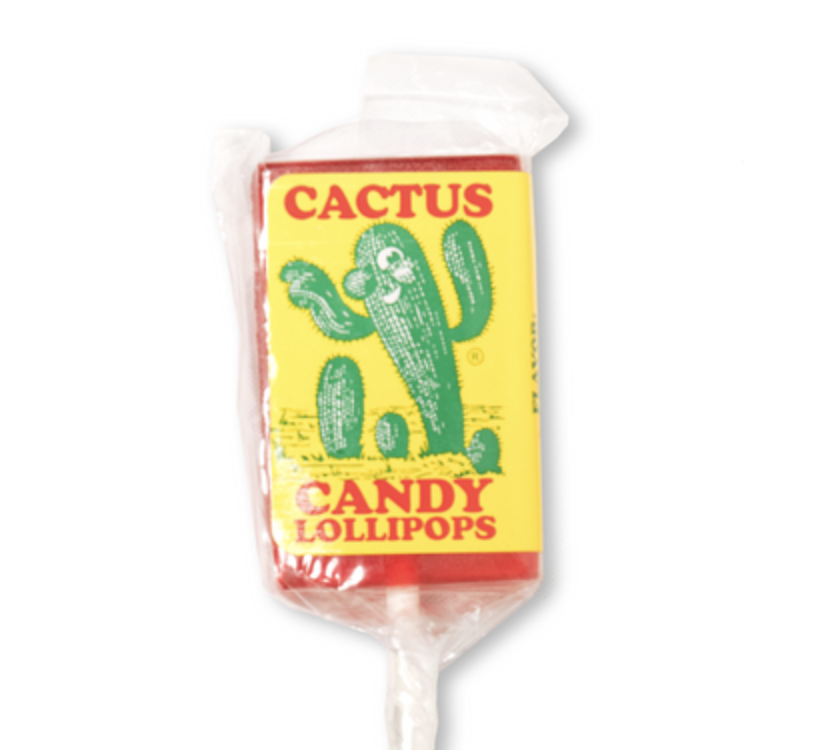
• Prickly Pear Lollipops Mix (Amazon): this set of lollipops includes a mix of more familiar fruit flavors as well as the still relatively rare prickly pear flavor.
